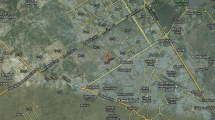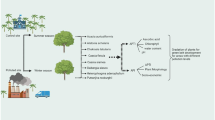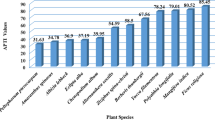Abstract
Industrialization and globalization have resulted in pollution of all the three ecosystems, including soil, water, and air. Among these, air pollution has generated much interest, since it has a major influence on the transboundary dispersion of pollutants globally. Air pollution tolerance index (APTI) value represents tolerance level of plants which help in selecting the most suitable plant species for plantation in/around affected areas. This parameter in conjunction with Anticipated Performance Index (API) can provide a logical solution for green belt development by considering biological and socio-economic aspect of the species and help in reducing the levels of pollutants. The present study was conducted in Himachal Pradesh, constituting a very vital part of the Indian Himalayan Region. In the present study, APTI and API values of six commonly growing temperate and sub-temperate plant species viz., Quercus leucotrichophora, Rubus ellipticus, Debregeasia saeneb, Hypericum oblongifolium, Punica granatum, and Grevillea robusta, were evaluated along the National Highway-5 in Himachal Pradesh. The highest value of APTI was observed for Grevillea robusta (12.89), followed by Punica granatum (10.87), Debregeasia saeneb (10.50), Hypericum oblongifolium (10.43), Rubus ellipticus (10.18), and Quercus leucotrichophora (9.68). Upon assessment of API, it was observed that Grevillea robusta (62.50%) was the highest scoring plant species in trees, while Rubus ellipticus and Debregeasia saeneb were the highest scoring shrub species (56.25% each) and thus can be recommended for green belt development and attenuation of air pollution in the region. Punica granatum can be suggested for plantation among the native species.



Similar content being viewed by others
References
A.O.A.C. (1980). Official methods of analysis of the analytical chemist, 13th ed. (W. Horwitz, ed.). Association of Analytical Chemists, 83, 617–623.
Agbaire, P. O., & Esiefarienrhe, E. (2009). Air pollution tolerance indices of some plants around Otorogun gas plant in Delta state, Nigeria. Journal of Applied Sciences and Environmental Management, 13(1), 11–14.
Amulya, L., Kumar, N. K. H., & Jagannath, S. (2015). Air pollution impact on micro morphological and biochemical response of Tabernaemontana divaricata L. (Gentianales: Apocynaceae) and Hamelia patens Jacq. (Gentianales: Rubiaceae). Brazilian Journal of Biological Sciences, 2(4), 287–294.
Anthony P (2001) Dust from walking tracks, impact on rainforest leaves on epiphylls, Cooperative Research Centre for Tropical Rainforest Ecology and Management, Australia pp 2.
Babu, G. B., Parveen, S. N., Kumar, N. K., & Reddy, M. S. (2013). Evaluation of air pollution tolerance indices of plant species growing in the vicinity of cement industry and Yogi Vemana University campus. Indian Journal of Advances in Chemical Science, 2(1), 16–20.
Bakiyaraj, R., & Ayyappan, D. (2014). Air pollution tolerance index of some terrestrial plants around an industrial area. International Journal of Modern Research and Reviews, 2(1), 1–7.
Barrs, H. D., & Weatherley, P. E. (1962). A re-examination of the relative turgidity technique for estimating water deficit in leaves. Australian Journal of Biological Sciences, 15, 413–428.
Bhattacharya, T., Kriplani, L., & Chakraborty, S. (2013). Seasonal variation in air pollution tolerance index of various plant species of Baroda city. Universal Journal of Environmental Research and Technology, 3(2), 199–201.
Bora, M., & Joshi, N. (2014). A study on variation in biochemical aspects of different tree species with tolerance and performance index. The Bioscan, 9(1), 59–63.
Chauhan, A., Iqbal, S., Maheshwari, R. S., & Bafna, A. (2012). Study of air pollution tolerance index of plants growing in Pithampur industrial area sector 1, 2 and 3. Research Journal of Recent Sciences, 1, 172–177.
Das, S., & Prasad, P. (2010). Seasonal variation in air pollution tolerance indices and selection of plant species for industrial areas of Rourkela. Indian Journal of Environmental Protection, 30(12), 978–988.
Dedio, W. (1975). Water relations in wheat leaves as screening tests for drought resistance. Canadian Journal of Plant Science, 55, 369–378.
Deepalakshmi, A. P., Ramakrishnaiah, H., Ramachandra, Y. L., & Radhika, R. N. (2013). Roadside plants as bio-indicators of urban air pollution. IOSR Journal of Environmental Science, Toxicology and Food Technology, 3(3), 10–14.
Dhankhar, R., Mor, V., Lilly, S., Chopra, K., & Khokhar, A. (2015). Evaluation of anticipated performance index of some tree species of Rohtak city, Haryana, India. International Journal of Recent Scientific Research, 6(3), 2890–2896.
Dwivedi, A. K., & Tripathi, B. D. (2007). Pollution tolerance and distribution pattern of plants in surrounding area of coal-fired industries. Journal of Environmental Biology, 28(2), 257–263.
Enete, I. C., Chukwudeluzu, V. U., & Okolie, A. O. (2013). Evaluation of air pollution tolerance index of plants and ornamental shrubs in Enugu City: Implications for urban Heat Island effect. World Environment, 3(3), 108–115.
Esfahani, A. A., Amini, H., Samadi, N., Kar, S., Hoodaji, M., Shirvani, M., & Porsakhi, K. (2013). Assessment of air pollution tolerance index of higher plants suitable for green belt development in east of Esfahan city, Iran. Journal of Ornamental and Horticultural Plants, 3(2), 87–94.
Ganguly, S., Das, M., & Mukherjee, A. (2017). Anticipated performance index (API) of some selected phanerophytes considered for Green Belt development. Research Journal of Pharmaceutical, Biological and Chemical Sciences, 8(3), 525–532.
Gholami, A., Mojiri, A., & Amini, H. (2016). Investigation of the air pollution tolerance index (APTI) using some plant species in Ahvaz region. The Journal of Animal and Plant Sciences, 26(2), 475–480.
Gomez, K. A., & Gomez, A. A. (1984). Statistical procedures for agricultural research (2 nd ed.) (p. 680). New York: John Wiley and Sons.
Hiscox, J. D., & Israelstam, G. F. (1979). A method for the extraction of chlorophyll from leaf tissue without maceration. Canadian Journal of Botany, 57, 1332–1334.
Joshi, P. C., & Swami, A. (2007). Physiological responses of some trees under roadside automobile pollution stress around city of Haridwar, India. Environmentalist, 27, 365–374.
Joshi, P. C., & Swami, A. (2009). Air pollution induced changes in the photosynthetic pigments of selected plant species. Journal of Environmental Biology, 30(2), 295–298.
Joshi, N., Chauhan, A., & Joshi, P. C. (2009). Impact of industrial air pollutants on some biochemical parameters and yield in wheat and mustard plants. Environmentalist, 29(4), 398–404.
Jyothi, S. J., & Jaya, D. S. (2010). Evaluation of air pollution tolerance index of selected plant species along roadsides in Thiruvananthapuram, Kerala. Journal of Environmental Biology, 31(3), 379–386.
Kaur, M., & Nagpal, A. K. (2017). Evaluation of air pollution tolerance index and anticipated performance index of plants and their application in development of green space along the urban areas. Environmental Science and Pollution Research, 24, 18881–18895.
Krishnaveni, G., & Kumar, K. K. (2018). Air pollution tolerance index of selected plants in Vijayawada city, Andhra Pradesh. International Journal of Green Pharmacy, 11(4), S877–S881.
Krishnaveni, M., & Lavanya, K. (2014). Air pollution tolerance index of plants: A comparative study. International Journal of Pharmacy and Pharmaceutical Sciences, 6(5), 320–324.
Kumari, J., & Deswal, S. (2017). Assessment of air pollution tolerance index of selected plants unveil to traffic roads of Noida, Uttar Pradesh. International Journal on Emerging Technologies, 8(1), 179–184.
Lakshmi, P. S., Sravanti, K. L., & Srinivas, N. (2009). Air pollution tolerance index of various plant species growing in industrial areas. The Ecoscan, 2(2), 203–206.
Liu, Y., & Ding, H. (2008). Variation in air pollution tolerance index of plants near a steel factory: Implications for landscape-plant species selection for industrial areas. WSEAS Transactions on Environment and Development, 4(1), 24–32.
Maawali, R. A., & Sulaiman, H. (2017). Trees for air pollution tolerance to develop green belts as an ecological mitigation. World Academy of Science, Engineering and Technology. International Journal of Environmental, Chemical, Ecological, Geological and Geophysical Engineering, 11(2), 106–109.
Malhotra, S. S., & Khan, A. A. (1984). Biochemical and biophysical impact of major pollutants. In M. Treshow (Ed.), Air pollution and plant life (pp. 113–157). New York: John Wiley and Sons.
Narwaria, Y. S., & Kushwah, K. (2012). Environmental assessment of air pollution on roadside plant species at Dehradun, Uttarakhand, India. Journal of Environmental Research and Development, 7(2), 710–714.
Ogunkunle, C. O., Suleiman, L. B., Oyedeji, S., Awotoye, O. O., & Fatoba, P. O. (2015). Assessing the air pollution tolerance index and anticipated performance index of some tree species for biomonitoring environmental health. Agroforestry Systems, 89, 447–454.
Pandey, A. K., Pandey, M., Mishra, A., Tiwary, S. M., & Tripathi, B. D. (2015). Air pollution tolerance index and anticipated performance index of some plant species for development of urban forest. Urban Forestry & Urban Greening, 14, 866–871.
Patel, A. M., & Kousar, H. (2011). Assessment of relative water content, leaf extract pH, ascorbic acid and total chlorophyll of some plants species growing in Shivamoga. Plant Archives, 11, 935–939.
Prajapati, S. K., & Tripathi, B. D. (2008). Seasonal variation of leaf dust accumulation and pigment content in plant species exposed to urban particulates pollution. Journal of Environmental Quality, 37, 865–870.
Radhapriya, P., Gopalakrishnan, A. N., Malini, P., & Ramachandran, A. (2012). Assessment of air pollution tolerance levels of selected plants around cement industry, Coimbatore, India. Journal of Environmental Biology, 33, 635–641.
Rai, P. K., & Panda, L. L. S. (2014). Leaf dust deposition and its impact on biochemical aspect of some roadside plants of Aizawl, Mizoram, north East India. International Research Journal of Environment Sciences, 3(11), 14–19.
Rai, P. K., Panda, L. L. S., & Chutia, B. M. (2014). Assessment of air pollution tolerance indices for certain roadside plants in Aizawl, Mizoram, India. The Ecoscan, 8(1–2), 33–39.
Ranganna, S. (2008). Ref. handbook of analysis and quality control for fruit and vegetable products (2nd ed.pp. 106–107). New Delhi (15th reprint: Tata McGraw-hill publishing company ltd.
Rawal, D. S., Sijapati, J. S., Rana, N., & Pradhananga, T. M. (2001). Air pollution tolerance index of some tree species of Kathmandu Valley, Nepal. Journal of Science and Technology, 3, 119–122.
Sahu, C., & Sahu, S. K. (2015). Air pollution tolerance index (APTI), anticipated performance index (API), carbon sequestration and dust collection potential of Indian tree species – A review. International Journal of Emerging Research in Management & Technology, 4(11), 37–40.
Satpute, S. B., & Bhalerao, S. A. (2017). Assessment of air pollution tolerance index (APTI) and anticipated performance index (API) for designing green belt. Research Journal of Chemical and Environmental Sciences, 5(1), 86–94.
Saxena, P., & Ghosh, C. (2015). A sustainable approach towards minimizing atmospheric benzene by the use of plants. International Journal of Agriculture and Crop Sciences, 8(3), 495–502.
Scholz, F., & Reck, S. (1977). Effects of acids on forest trees as measured by titration invitro inheritance of buffering capacity in Picea abies. Water, Air, and Soil Pollution, 8, 41–45.
Sharma, B., Sharma, S., & Bhardwaj, S. K. (2017a). Plant- pollutant interactions with a special mention of dust accumulation by plants - A review. Nature, Environment and Pollution Technology, 16(2), 375–384.
Sharma, B., Sharma, S., Bhardwaj, S. K., & Alam, N. M. (2017b). Effect of pollution on Total chlorophyll content in temperate species growing along National Highway 5 in Himachal Pradesh. International Journal of Advances in Science Engineering and Technology, 5(3), 72–75.
Sharma B, Sharma S and Bhardwaj SK (2017c) Effect of pollution on relative water content in temperate species growing along National Highway 5 in Himachal Pradesh. Proceedings of IEEEFORUM. International conference on forestry, food and sustainable agriculture, New Delhi (20th august 2017) pp 32–35.
Singare, P. U., & Talpade, M. S. (2013). Physiological responses of some plant species as a bio-indicator of roadside automobile pollution stress using the air pollution tolerance index approach. International Journal of Plant Research, 3(2), 9–16.
Singh, S. K. (1977). Practical plant physiology (p. 226). New Delhi: Kalayani Publishers.
Singh N (2012) Assessment of air pollution tolerance index of certain plants grown alongside Parwanoo-Solan National Highway of Himachal Pradesh, Ph.D. thesis. Dr. Y.S. Parmar University of Horticulture and Forestry, Nauni, pp 57.
Singh, SK and Rao DN (1983) Evaluation of the plants for their tolerance to air pollution. Proceedings in: Symposium on Air Pollution control held at IIT, Delhi, pp 218–224.
Singh, S. K., Rao, D. N., Agrawal, M., Pande, J., & Narayan, D. (1991). Air pollution tolerance index of plants. Journal of Environmental Management, 32, 45–55.
Singh, S., Tiwari, S., Singh, R., & Chate, D. (2018). Air pollutants concern in field crops under changing environment scenarios. Journal of Agrometeorology, 20(Special Issue), 302–306.
Spatt, P. D., & Miller, C. (1981). Growth conditions and vitality of Sphagnum in a tundra community along the Alaska pipeline haul road. Arctic, 34(1), 48–54.
Suganthi, P., Ganeshkumar, R. S., Govindaraju, M., Selvaraj, M., & Kumar, P. (2013). Estimation of biochemical characters of plants in response to vehicular air pollution stress in Riruchirappalli city corporation, Tamil Nadu, India. International Journal of Recent Scientific Research, 4(8), 1282–1289.
Swami, A., Bhatt, D., & Joshi, P. C. (2004). Effect of automobile pollution on Sal (Shorea robusta) and Rohini (Mallotus phillipensis) at Asarori, Dehradun. Himalayan Journal of Environment and Zoology, 8(1), 57–61.
Tak, A. A., & Kakdea, U. B. (2017). Assessment of air pollution tolerance index of plants: A comparative study. International Journal of Pharmacy and Pharmaceutical Sciences, 9(7), 83–89.
Tanee, F. B. G., & Albert, E. (2013). Air pollution tolerance indices of plants growing around Umuebulu gas Flare Station in river state, Nigeria. African Journal of Environmental Science and Technology, 7(1), 1–8.
Tiwari, S., Agrawal, M., & Marshall, F. M. (2006). Evaluation of ambient air pollution impact on carrot plants at a sub urban site using open top chambers. Environmental Monitoring and Assessment, 119, 15–30.
Traffic count: http://www.ctre.iastate.edu/pubs/traffichandbook/3trafficcounts.pdf (Accessed on 14th March, 2013).
Tripathi, A. K., & Gautam, M. (2007). Biochemical parameters of plants as indicators of air pollution. Journal of Environmental Biology, 28, 127–132.
Tyagi, S., Tiwari, S., Mishra, A., Singh, S., Hopke, P. K., Singh, S., & Attri, S. D. (2017). Characteristics of absorbing aerosols during winter foggy period over the National Capital Region of Delhi: Impact of planetary boundary layer dynamics and solar radiation flux. Atmospheric Research, 188, 1–10.
Author information
Authors and Affiliations
Corresponding author
Additional information
Publisher’s note
Springer Nature remains neutral with regard to jurisdictional claims in published maps and institutional affiliations.
Rights and permissions
About this article
Cite this article
Sharma, B., Bhardwaj, S.K., Sharma, S. et al. Pollution tolerance assessment of temperate woody vegetation growing along the National Highway-5 in Himachal Pradesh, India. Environ Monit Assess 191, 177 (2019). https://doi.org/10.1007/s10661-019-7310-x
Received:
Accepted:
Published:
DOI: https://doi.org/10.1007/s10661-019-7310-x




